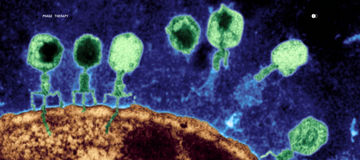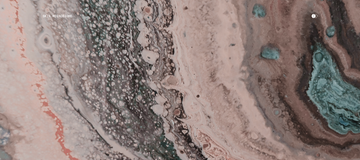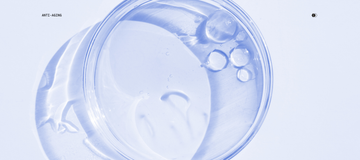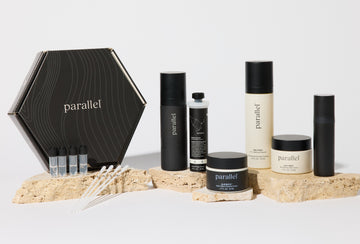The "Glow Trap": TikTok's Skincare Obsession is Destroying Your Skin Microbiome
by Parallel Health Team
The pursuit of perfect, filter-like skin has led to an unexpected consequence: a wave of inflammatory skin conditions sweeping millions, from Gen Alpha to Millennials. Dermatologists are now calling this phenomenon "influencer inflammation," and it's become so widespread that it's earned the name—the "glow trap."
What is Influencer Inflammation?
Canadian dermatologist Dr. Sandy Skotnicki coined the term "influencer inflammation" to describe a new form of irritant dermatitis caused by excessive use of multiple active skincare ingredients and products simultaneously. In her practice, she's seeing an alarming increase in patients, primarily women aged 18-30, who believe they've suddenly developed sensitive skin. But it's not genetics– it's the assault on your skin of too many products, often not vetted for quality.
Recent research published in Pediatrics provides quantitative context to this trend. Analyzing 100 TikTok videos, researchers found children as young as seven implementing routines averaging six products and 11 potentially irritating active ingredients. And despite the prevalence of photosensitizing acids like AHAs and retinoids, only 26% of daytime routines incorporated sunscreen.
The Science Behind the Damage
The skin microbiome—the diverse community of microorganisms living on your skin—plays a crucial role in maintaining skin health, immune defense, and protection against pathogens. When this delicate ecosystem is disrupted through excessive product use, it leads to microbial dysbiosis, triggering inflammation, irritation, and chronic sensitization.
Research published in BMC Biology demonstrates that skincare products can alter both the chemical composition and microbial diversity of skin. Some ingredients persist on the skin for weeks, creating long-term effects on the skin's ecosystem. Studies show that daily use of multiple cosmetics significantly changes the skin's microbial community structure, sometimes promoting beneficial bacteria but often causing harmful perturbations when products are overused or improperly combined.
The Algorithm Caused the Glow Trap
TikTok's algorithm rewards visually dramatic content—tutorials showing serums pouring like water, rapid-fire routines set to music, and promises of overnight transformations. The platform has normalized the idea that skincare should be a performance rather than an act of self-care. This creates a toxic cycle where natural skin is viewed as flawed, and every imperfection becomes something to "fix" with more products.
The promise of glass skin, porcelain complexions, and glazed-donut glow has convinced entire generations that complex, multi-step routines equal beauty and health. Meanwhile, the skin is undergoing chronic low-grade stress, depleting barrier lipids, and compromising microbial defenses.
Engineering Microbiome Health
At Parallel Health, we see this phenomenon reflected in our own microbiome data. With initial skin microbiome testing in month 1 for members of the MD-03 Protocol™, we often detect those who use extraneous products or layer more products than their skin actually needs. In these patients, we see how their prior regimen has disrupted microbial balance that compromises skin health rather than enhancing it.
Our methodology inverts the more-is-more paradigm. Instead of adding more products, we use advanced skin microbiome testing, precision phage therapy to naturally target and eliminate harmful bacteria, calming biotics, bioactive peptides, and custom compounded prescriptions as precision care. We believe you should use what you absolutely need– nothing more. Our goal is to help you engineer your microbiome for genuine skin longevity, not just temporary glow.
True skin health isn't about more steps or more actives. It's about restoring balance, supporting your skin's natural ecosystem, and using targeted, science-backed interventions that work with your microbiome, not against it.
Rethinking Skincare Through a Microbial Lens
The glow trap is real, and it's leaving a generation with damaged skin barriers, chronic inflammation, and early sensitization. Healthy skin isn't a product of external perfection imposed through chemistry, but rather the outward expression of balanced internal ecology. As microbiome science advances, the skincare paradigm must shift from intervention to collaboration with our resident microbial communities.
References
-
Hales, M., Lagu, T., et al. (2025). Pediatric skin care regimens on TikTok. Pediatrics, 156(1): e2024070309. https://publications.aap.org/pediatrics/article/156/1/e2024070309/202103
-
Song, S.J., et al. (2019). The impact of skin care products on skin chemistry and microbiome dynamics. BMC Biology, 17, 47. https://bmcbiol.biomedcentral.com/articles/10.1186/s12915-019-0660-6
-
Hwang, J., et al. (2021). Effect of the skincare product on facial skin microbial structure and biophysical parameters: A pilot study. MicrobiologyOpen, 10(5), e1236. https://onlinelibrary.wiley.com/doi/full/10.1002/mbo3.1236
-
Ciardiello, T., et al. (2024). The dynamic relationship between skin microbiomes and personal care products: A comprehensive review. Heliyon, 10(14). https://www.sciencedirect.com/science/article/pii/S2405844024105804
-
Chen, Y.E., Fischbach, M.A., & Belkaid, Y. (2018). Skin microbiota–host interactions. Nature, 553(7689), 427-436.
-
Kumar, S., et al. (2025). Microbiome and Postbiotics in Skin Health. Biomedicines, 13(4), 791. https://www.mdpi.com/2227-9059/13/4/791




























